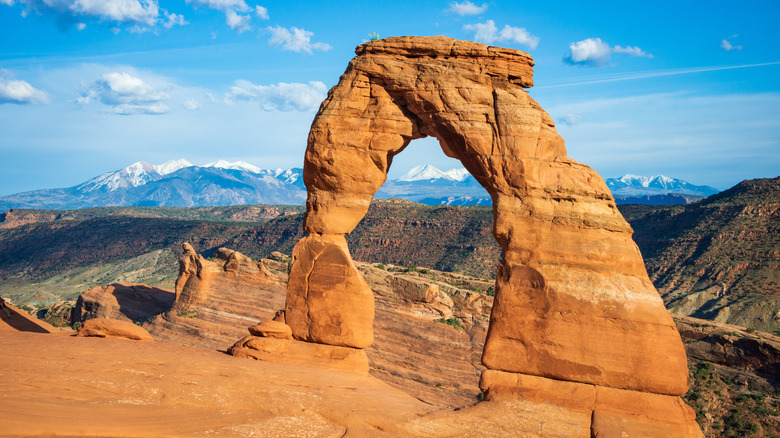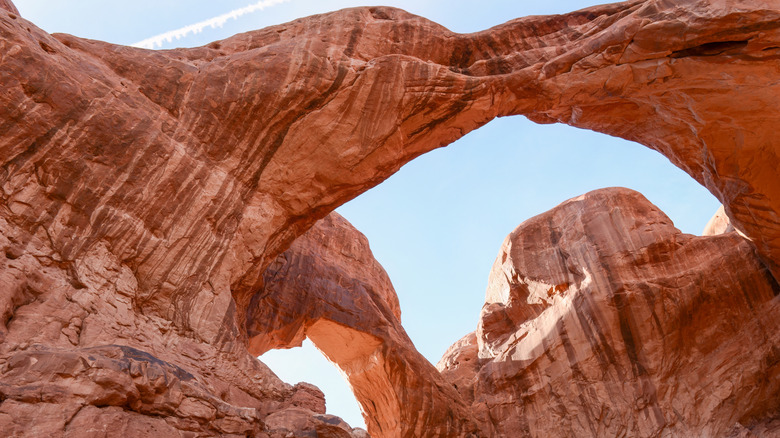The State With The Most Natural Arches Offers A Stunning Playground For Adventurers
Utah is a popular hub for outdoor adventurers. While most of the attention goes to big-name parks Zion and Moab, there's a whole state full of unique geology to explore in between, from canyons and mountains to staircases and arches. All kinds of outdoorsy folks, from casual hikers to serious climbers, come from far and wide to enjoy the state's unique landscape. Home to five national parks, including some of the most-visited parks in the country, there are stunning trails and landmarks everywhere you turn.
Of all of those landmarks, arches are the most associated with the state. Utah is, in fact, the state with the most natural arches, and these formations are more common than you may think. They're so prevalent that Utah even has a park named after the features: Arches National Park. The state draws in millions of visitors every year to its national parks alone, from serious climbers looking to get onto an arch to families and casual tourists aiming to enjoy this outdoors playground.
No matter what skill level you'd consider yourself at as a outdoor adventurer, Utah is teeming with excitement. And the arches are just as beautiful from afar as they are up close. The proximity to Arches, Canyonlands, and state parks like Dead Horse makes Moab a great central home base, with plenty of restaurants, shops, and other outdoor enthusiasts hanging around. Between all the hikes and other activities, it would be hard to run out of new side quests.
Visit Arches National Park and Canyonlands National Park
When people think of natural arches out west, the park named for the formation probably comes to mind, and for good reason. Arches National Park has the highest concentration of natural arches of any one area in the world. While the park is relatively small, you can easily spend several days here, exploring and hiking to the different arches, and climbing up natural rock formations. There are several famous options in this park, including Delicate Arch (one of the most well-known), Landscape Arch (North America's longest arch), and the window arches, which include Double Arch, Turret Arch, and the North Window. Many can be hiked to, and even climbed inside of, to capture that perfect picture of the park. There are even a few hidden gems you can hike to without the usual crowds the park is known for.
Of all the arches, the hike to Delicate Arch is the most popular in the park, according to travel and lifestyle blogger Still Busy Baking. There are two views of Delicate Arch. The lower view has a much shorter, easier walk than the upper route, which takes about 3-4 hours to complete. You do not need a permit to complete this hike, but it's a good idea to plan your visit, as the trail can be quite crowded during peak travel seasons.
Arches National Park is home to some of the most famous and most visited natural arches in the country. These rock formations, though, are not limited to just their namesake park. If you're visiting the Moab area, you'll come across arches all over. While Canyonlands National Park is known more for its Grand Canyon-esque landscape, it's also home to several natural arches, through which you'll see a jaw-dropping view of the canyons.
Explore how Utah's unique natural arches formed
Utah is home to the most natural arches on the planet. There are over 2,000 in Arches National Park alone. And for that to happen, the conditions had to be just right, starting with the kinds of rock and sand prevalent in the state. Utah has a lot of sandstone, which makes up these geological formations. For the arches to become the formations we know, the National Park Service explains that "first, geologic forces wrinkled and folded the buried sandstone, as if it were a giant rug and someone gathered two edges towards each other, making lumps across the middle called Anticlines. As the sandstone warped, fractures tore through it, establishing the patterns for rock sculptures of the future." That was where the bodies of these arches came from, yet they were still just large shapes.
According to the National Park Service, with the help of erosion from rainwater, snow, and time, "small recesses develop and grow bigger with each storm. Little by little, this process turns fractured rock layers into fins, and fins into arches." This process, the most common way for arches to form, takes thousands of years, if not millions. Though they're not forever. Scientists say that many of Utah's breathtaking arches will fall, as the park's Wall Arch did in 2008. Luckily, most arches are expected to continue standing well after the lifetime of anyone currently on Earth, and in turn will keep making this part of the country such a special and unique place for adventurers to explore.


